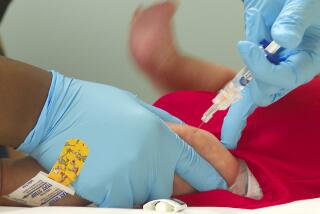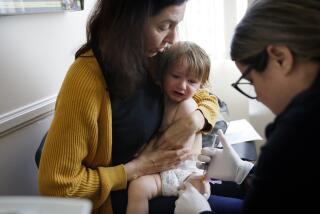Hepatitis A Infections Dramatically Reduced in U.S.
- Share via
The rate of hepatitis A infections in the United States has shrunk by 76% since a vaccination program targeting children in 17 high-risk states began in 1999, said a report published Wednesday in the Journal of the American Medical Assn.
The program drove the rate of infection down to 2.6 cases per 100,000 people, or 7,653 cases, in 2003, the latest year for which figures were available.
It is the lowest rate since the disease began being monitored in the 1960s, the report said.
The program’s biggest effect has been on children ages 2 to 9. Their infection rate nationwide has dropped 89% in the last six years, from 18.1 cases per 100,000 children to two cases per 100,000. A decline of 84% occurred among children ages 10 to 18.
Epidemiologist Annemarie Wasley of the federal Centers for Disease Control and Prevention said it was heartening to see the effect of the agency’s vaccination strategy.
“It’s nice when common sense actually works,” said Wasley, lead author of the report.
Hepatitis A is a liver disease that causes fever, nausea, abdominal discomfort and jaundice.
Symptoms typically last less than two months and rarely lead to death.
The virus that causes hepatitis A is most commonly spread in poor sanitary conditions through physical contact with infected people or feces.
Children are most prone to pass the virus because they frequently carry it without showing symptoms.
“When kids play together, there’s a lot of close personal contact, and they’re not particularly paying attention to hygiene,” Wasley said.
Analysis of infection rates in the late 1990s showed that about 65% of all cases in the United States were found in 17 states, largely concentrated in the West and Southwest.
The high-risk states averaged at least 10 infections per 100,000 people from 1987 to 1997, with 11 states, including California, averaging 20 or more cases per 100,000.
Low-risk states averaged fewer than six cases per 100,000 over that period.
Hepatitis A vaccinations had been focused on gay men, intravenous drug users, Native Americans and overseas travelers.
Geographic analysis showed that the strategy was missing a large group of infections.
“Targets are not typically based on geography,” Wasley said. “But the natural focus should be where the highest rates” exist.
The CDC issued a recommendation in 1999 that encouraged the routine vaccination of children living in the high-risk states.
Although it was a recommendation, some states started requiring a vaccination for entry into day-care and preschool programs, Wasley said.
A vaccination consists of two shots, delivered six months apart, and costs about $12 per shot.
Infection rates in the high-risk states are now no different than the rates in the rest of the country.
More to Read
Sign up for Essential California
The most important California stories and recommendations in your inbox every morning.
You may occasionally receive promotional content from the Los Angeles Times.










